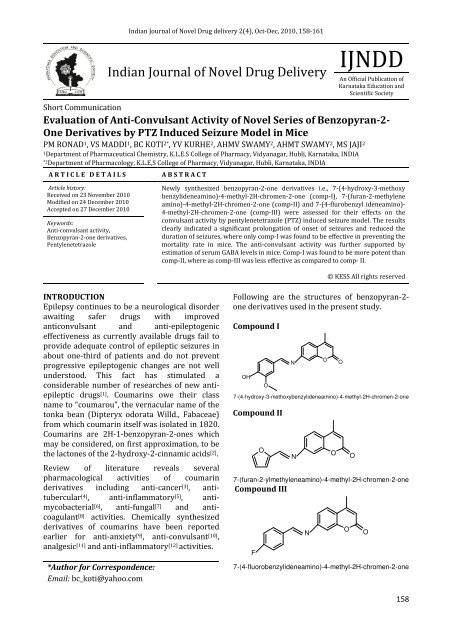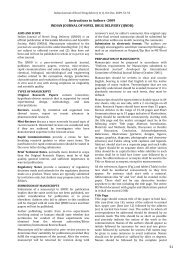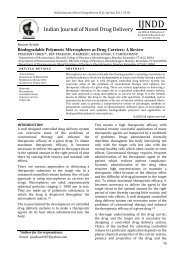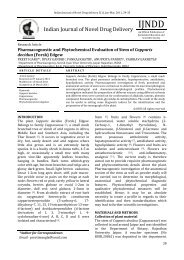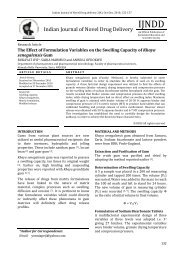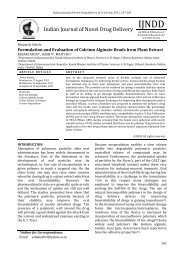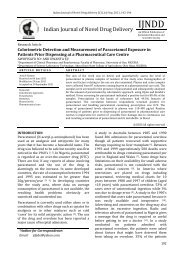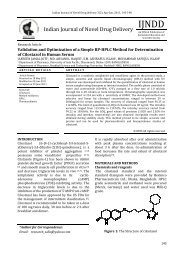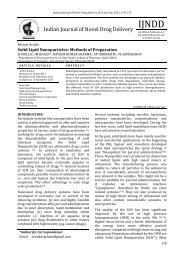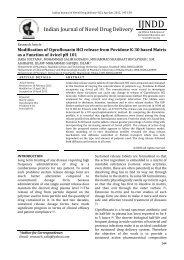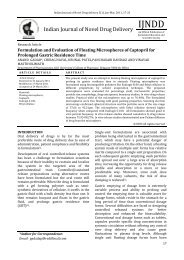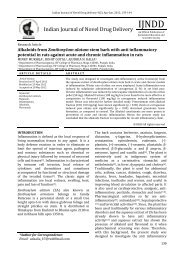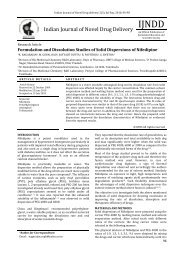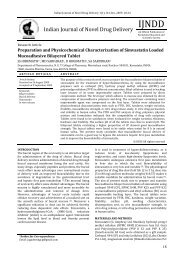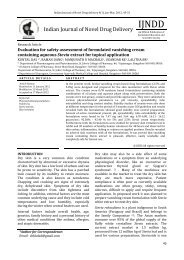Evaluation of Anti-Convulsant Activity of Novel Series of Benzopyran-2
Evaluation of Anti-Convulsant Activity of Novel Series of Benzopyran-2
Evaluation of Anti-Convulsant Activity of Novel Series of Benzopyran-2
Create successful ePaper yourself
Turn your PDF publications into a flip-book with our unique Google optimized e-Paper software.
Indian Journal <strong>of</strong> <strong>Novel</strong> Drug delivery 2(4), Oct-Dec, 2010, 158-161<br />
Indian Journal <strong>of</strong> <strong>Novel</strong> Drug Delivery<br />
IJNDD<br />
An Official Publication <strong>of</strong><br />
Karnataka Education and<br />
Scientific Society<br />
Short Communication<br />
<strong>Evaluation</strong> <strong>of</strong> <strong>Anti</strong>-<strong>Convulsant</strong> <strong>Activity</strong> <strong>of</strong> <strong>Novel</strong> <strong>Series</strong> <strong>of</strong> <strong>Benzopyran</strong>-2-<br />
One Derivatives by PTZ Induced Seizure Model in Mice<br />
PM RONAD 1 , VS MADDI 1 , BC KOTI 2* , YV KURHE 2 , AHMV SWAMY 2 , AHMT SWAMY 2 , MS JAJI 2<br />
1Department <strong>of</strong> Pharmaceutical Chemistry, K.L.E.S College <strong>of</strong> Pharmacy, Vidyanagar, Hubli, Karnataka, INDIA<br />
*2Department <strong>of</strong> Pharmacology, K.L.E,S College <strong>of</strong> Pharmacy, Vidyanagar, Hubli, Karnataka, INDIA<br />
A R T I C L E D E T A I L S<br />
A B S T R A C T<br />
Article history:<br />
Received on 23 November 2010<br />
Modified on 24 December 2010<br />
Accepted on 27 December 2010<br />
Keywords:<br />
<strong>Anti</strong>-convulsant activity,<br />
<strong>Benzopyran</strong>-2-one derivatives,<br />
Pentylenetetrazole<br />
Newly synthesized benzopyran-2-one derivatives i.e., 7-(4-hydroxy-3-methoxy<br />
benzylideneamino)-4-methyl-2H-chromen-2-one (comp-I), 7-(furan-2-methylene<br />
amino)-4-methyl-2H-chromen-2-one (comp-II) and 7-(4-flurobenzyl ideneamino)-<br />
4-methyl-2H-chromen-2-one (comp-III) were assessed for their effects on the<br />
convulsant activity by pentylenetetrazole (PTZ) induced seizure model. The results<br />
clearly indicated a significant prolongation <strong>of</strong> onset <strong>of</strong> seizures and reduced the<br />
duration <strong>of</strong> seizures, where only comp-I was found to be effective in preventing the<br />
mortality rate in mice. The anti-convulsant activity was further supported by<br />
estimation <strong>of</strong> serum GABA levels in mice. Comp-I was found to be more potent than<br />
comp-II, where as comp-III was less effective as compared to comp- II.<br />
© KESS All rights reserved<br />
INTRODUCTION<br />
Epilepsy continues to be a neurological disorder<br />
awaiting safer drugs with improved<br />
anticonvulsant and anti-epileptogenic<br />
effectiveness as currently available drugs fail to<br />
provide adequate control <strong>of</strong> epileptic seizures in<br />
about one-third <strong>of</strong> patients and do not prevent<br />
progressive epileptogenic changes are not well<br />
understood. This fact has stimulated a<br />
considerable number <strong>of</strong> researches <strong>of</strong> new antiepileptic<br />
drugs [1] . Coumarins owe their class<br />
name to “coumarou”, the vernacular name <strong>of</strong> the<br />
tonka bean (Dipteryx odorata Willd., Fabaceae)<br />
from which coumarin itself was isolated in 1820.<br />
Coumarins are 2H-1-benzopyran-2-ones which<br />
may be considered, on first approximation, to be<br />
the lactones <strong>of</strong> the 2-hydroxy-2-cinnamic acids [2] .<br />
Review <strong>of</strong> literature reveals several<br />
pharmacological activities <strong>of</strong> coumarin<br />
derivatives including anti-cancer [3] , antitubercular<br />
[4] , anti-inflammatory [5] , antimycobacterial<br />
[6] , anti-fungal [7] and anticoagulant<br />
[8] activities. Chemically synthesized<br />
derivatives <strong>of</strong> coumarins have been reported<br />
earlier for anti-anxiety [9] , anti-convulsant [10] ,<br />
analgesic [11] and anti-inflammatory [12] activities.<br />
*Author for Correspondence:<br />
Email: bc_koti@yahoo.com<br />
Following are the structures <strong>of</strong> benzopyran-2-<br />
one derivatives used in the present study.<br />
Compound I<br />
OH<br />
O<br />
N<br />
7-(4-hydroxy-3-methoxybenzylideneamino)-4-methyl-2H-chromen-2-one<br />
Compound II<br />
O<br />
N<br />
7-(furan-2-ylmethyleneamino)-4-methyl-2H-chromen-2-one<br />
Compound III<br />
F<br />
N<br />
7-(4-fluorobenzylideneamino)-4-methyl-2H-chromen-2-one<br />
O<br />
O<br />
O<br />
O<br />
O<br />
O<br />
158
BC Koti et al / Indian Journal <strong>of</strong> <strong>Novel</strong> Drug Delivery 2(4), Oct-Dec, 2010, 158-161<br />
Hence, the present attempt deals with the<br />
investigation <strong>of</strong> the anti-convulsant effect <strong>of</strong><br />
novel benzopyran-2-one derivatives such as 7-<br />
(4-hydroxy-3-methoxy benzylideneamino)-4-<br />
methyl-2H-chromen-2-one (comp-I), 7-(furan-2-<br />
methyleneamino)-4-methyl-2H-chromen-2-one<br />
(comp-II) and 7-(4-flurobenzylideneamino)-4-<br />
methyl-2H-chromen-2-one (comp-III) in mice.<br />
All the benzopyran-2-one derivatives i.e., 7-(4-<br />
hydroxy-3-methoxy benzylideneamino)-4-<br />
methyl-2H-chromen-2-one (comp-I), 7-(Furan-2-<br />
methyleneamino)-4-methyl-2H-chromen-2-one<br />
(comp-II) and 7-(4-Flurobenzylideneamino)-4-<br />
methyl-2H-chromen-2-one (comp-III) were<br />
synthesized by earlier reported method [13] .<br />
Diazepam 1 mg/kg p.o. (Azardo Pharma, India),<br />
PTZ 80 mg/kg i.p. (Sigma Chemical Co.,USA)<br />
were used. A suspension <strong>of</strong> 5% sodium carboxyl<br />
methyl cellulose (CMC) at a dose <strong>of</strong> 5 ml/kg p.o.<br />
was used as control. All the three test<br />
compounds comp-I, comp-II, comp-III were<br />
administered as a suspension <strong>of</strong> 5% sodium<br />
carboxyl methyl cellulose (CMC).<br />
Swiss albino mice <strong>of</strong> either sex (5-6-weeks-old)<br />
weighing 20-25g obtained from the animal house<br />
<strong>of</strong> K.L.E.’S College <strong>of</strong> Pharmacy, Hubli-31,<br />
Karnataka, India were used. The animals were<br />
housed under standard laboratory conditions<br />
(relative humidity 55-56 %, room temperature<br />
23.0 ± 2.0 0 C and 12 h light: dark cycle).The<br />
animals were fed with standard diet and water<br />
ad libitum. They were fasted overnight prior to<br />
experiment. All the animal experiments were<br />
approved from the animal ethical committee <strong>of</strong><br />
K.L.E.’S College <strong>of</strong> Pharmacy, Hubli, Karnataka,<br />
India.<br />
The toxicity test showed clinical signs and<br />
mortality <strong>of</strong> the animals at higher doses 2000<br />
mg/kg and 300 mg/kg p.o. for all the test<br />
compounds. Further, next dose i.e., 200 mg/kg<br />
p.o. dose was found to be non-lethal and hence,<br />
1/10 th <strong>of</strong> this non-lethal dose i.e., 20 mg/kg p.o.<br />
dose was selected for the anti-convulsant activity<br />
for all three benzopyran-2-one derivatives<br />
(comp-I, comp-II and comp-III). Toxicity study<br />
was carried out as per the OECD/OCDE guide<br />
lines no. 423.<br />
The mice (20-25 g) were divided into five groups<br />
<strong>of</strong> 6 animals each. Group-I served as control<br />
which received 5% sodium CMC (5 ml/kg p.o.)<br />
30 min before administration <strong>of</strong> PTZ (80 mg/kg<br />
i.p.). Group-II received diazepam (1 mg/kg p.o.)<br />
dissolved in a suspension <strong>of</strong> 5% sodium CMC as a<br />
standard reference drug. Groups-III, IV and V<br />
received comp-I, comp-II and comp-III at a dose<br />
<strong>of</strong> 20 mg/kg p.o dissolved in suspension <strong>of</strong> 5%<br />
sodium CMC respectively 30 min before the<br />
administration <strong>of</strong> PTZ (80 mg/kg i.p.). Each<br />
animal was placed into an individual plastic cage<br />
for observation lasting 1 h. The time taken before<br />
the onset <strong>of</strong> clonic convulsions, the duration <strong>of</strong><br />
clonic convulsions and percentage <strong>of</strong> mortality<br />
protection were recorded [14] .<br />
The GABA level in serum was assayed by paper<br />
chromatography method. The serum sample (0.1<br />
ml) was added to 1.5 ml <strong>of</strong> absolute alcohol and<br />
centrifuged at 3000 g for 15 minutes. The upper<br />
layer was aspirated and 0.3 ml was put on<br />
Whatman’s filter paper which was dipped in<br />
phenol solution for 24 hours and subsequently<br />
dried in air. Thereafter, ninhydrin salt solution<br />
was sprayed on chromatography paper and<br />
heated at 65 o C for 10 minutes. The spot,<br />
developed due to chromatographic mobility <strong>of</strong><br />
GABA, was cut and put in 3 ml solution <strong>of</strong><br />
absolute alcohol for elution.<br />
The optical density was measured using a<br />
spectrophotometer at wavelength <strong>of</strong> 509 nm and<br />
compared with standard solution [15] .<br />
O.D. <strong>of</strong> test X 1000 = pmol/ml<br />
O.D. <strong>of</strong> std<br />
Note: 1ug = 1000pg. Hence, to convert values into picogram<br />
(pg), values must be multiplied by 1000.<br />
Concentration <strong>of</strong> Standard GABA solution: 0.1 ug/ml<br />
The statistical analysis <strong>of</strong> result was carried out<br />
by using one-way ANOVA followed by Dunnet’s<br />
multiple comparison tests using graph pad prism<br />
in stat 5 Demo and all the results obtained in the<br />
study were compared with the vehicle control<br />
group. P values (p
BC Koti et al / Indian Journal <strong>of</strong> <strong>Novel</strong> Drug Delivery 2(4), Oct-Dec, 2010, 158-161<br />
Table 1: Effect <strong>of</strong> 7-Substituted Amino Coumarin Derivatives on Pentylenetetrazole (PTZ) - Induced<br />
Seizure in Mice<br />
Sl.No. Treatment Dose<br />
1 Control (5% sodium<br />
CMC+ PTZ)<br />
(mg/kg p.o.)<br />
5 ml/kg + 80<br />
mg/kg p.o.<br />
Onset <strong>of</strong><br />
Seizures(sec)<br />
Duration <strong>of</strong><br />
seizure(sec)<br />
Percentage <strong>of</strong><br />
mortality protection<br />
13.33 ± 0.49 14.00 ± 0.36 0.00 ± 0.00<br />
2 Compound-I 20 51.50 ± 1.11*** 8.73 ± 0.54*** 83.33 ± 16.6***<br />
3 Compound-II 20 40.33 ± 0.71*** 11.02 ± 0.37*** 0.00 ± 0.00<br />
4 Compound-III 20 26.0 ± 0.96*** 11.85 ± 0.22*** 0.00 ± 0.00<br />
5 Diazepam 1 596.8 ± 1.37*** 0.00 ± 0.00*** 100.0 ± 0.00***<br />
p value < 0.0001 < 0.0001 < 0.0001<br />
F value 66040 152.8 46.00<br />
GABA levels were significantly increased in the<br />
treated group as compared to that <strong>of</strong> control.<br />
(Table 2). GABA levels in the treated groups were<br />
found to be less than that <strong>of</strong> the standard GABA<br />
solution (0.1ug/ml). GABA levels <strong>of</strong> group<br />
treated with comp-I was found to be higher than<br />
that <strong>of</strong> comp-II and comp-III.<br />
Table 2: GABA Levels <strong>of</strong> All Three <strong>Benzopyran</strong>-<br />
2-One Derivatives Was Assayed and Compared<br />
With the Levels <strong>of</strong> Standard GABA<br />
SL.<br />
No.<br />
Treatment<br />
Optical<br />
Density (OD)<br />
at 509 nm<br />
1 Control 0.02 153.8<br />
2 Compound-I 0.09 692.3<br />
3 Compound-II 0.05 384.6<br />
4 Compound-III 0.03 230.7<br />
5 Diazepam 0.10 769.2<br />
6 Std. GABA 0.13 1000<br />
GABA levels<br />
pmol /ml<br />
<strong>Anti</strong>-convulsant activity in mice was determined<br />
by PTZ induced seizure model. All the three test<br />
derivatives were found effective in altering the<br />
onset and duration <strong>of</strong> seizures. Whereas, only<br />
comp-I was effective in protecting mortality in<br />
mice. From the results <strong>of</strong> GABA assay it clearly<br />
indicates that the test compounds may have<br />
exerted the possible anti-convulsant effect by<br />
reducing T-type Ca 2+ currents, increasing the<br />
GABA levels and enhancing the GABA A receptor<br />
mediated inhibitory neurotransmission 16 ,<br />
enhancing and facilitating GABA-mediated<br />
synaptic transmission and inhibition, an effect<br />
mediated either by a pre- or post- synaptic<br />
action. In presence <strong>of</strong> GABA, the GABA A receptor<br />
is opened, thus allowing an influx <strong>of</strong> Cl - ions,<br />
which in turn increases membrane polarization<br />
[17].<br />
ACKNOWLEDGMENTS<br />
Authors are thankful to Principal, KLES College <strong>of</strong><br />
Pharmacy, Hubli for providing necessary<br />
facilities to carry out this work.<br />
REFERENCES<br />
In conclusion, benzopyran-2-one derivatives i.e.,<br />
7-(4-hydroxy-3-methoxy benzylideneamino)-4-<br />
methyl-2H-chromen-2-one (comp-I), 7-(furan-2-<br />
methyleneamino)-4-methyl-2H-chromen-2-one<br />
(comp-II) and 7-(4-flurobenzylideneamino)-4-<br />
methyl-2H-chromen-2-one (comp-III) possess<br />
anti-convulsant activity, where comp-I was<br />
found to be more potent than comp-II whereas,<br />
comp-III was less potent than comp-II.<br />
[1] Quintans-Junior LJ, SouzaTT, Leite BS,<br />
Lessa NMN, Bonjardim LR, Santos MRV,<br />
Aives PB, Blank AF, Antoniolli AR.<br />
Phytochemical screening and<br />
anticonvulsant activity <strong>of</strong> Cymbopogon<br />
winterianus Jowitt (Poaceae) leaf essential<br />
oil in rodents. Phytomed 2008; 15: 619-24.<br />
[2] Bruneton J. Pharmacognosy and<br />
Phytochemistry <strong>of</strong> Medicinal Plants. 2nd<br />
ed. Lavoisier Publication; 1999.<br />
[3] Natala SR, Mallireddigari MR, Cosenza S,<br />
Gumireddy K, Bell SC, Reddy EP, Reddy<br />
VR. Synthesis <strong>of</strong> new coumarin 3-(N-aryl)<br />
sulfonamides and their anticancer activity.<br />
Bioorg Med Chem Lett 2004; 14: 4093-097.<br />
[4] Karali N, Kocabalkanli A, Gursoy A, Ates O.<br />
Synthesis and antitubercular activity <strong>of</strong> 4-<br />
(3-coumarinyl)-3-cyclohexyl-4-thiazolin-2-<br />
one benzylidene hydrazones. IL Farmaco<br />
2002; 57: 589-93.<br />
160
BC Koti et al / Indian Journal <strong>of</strong> <strong>Novel</strong> Drug Delivery 2(4), Oct-Dec, 2010, 158-161<br />
[5] Maddi V, Raghu KS, Rao MNA. Synthesis<br />
and anti-inflammatory activity <strong>of</strong> 3-<br />
(Benzylideneamino) coumarin in rodents. J<br />
Pharm Sci 1992; 81: 964-66.<br />
[6] Alvey L, Prado S, Huteau V, Saint-Joanis B,<br />
Sylvie M, Koch M, Cole ST, Tillequin F, Janin<br />
YL. A new synthetic access to furo[3,2-<br />
f]chromene analogues <strong>of</strong> an<br />
antimycobacterial. Bioorg Med Chem 2008;<br />
16: 8264-272.<br />
[7] Kalkhambkar RG, Kulkarni GM,<br />
Kamanavalli CM, Premkumar N, Asdaq<br />
SMB, Sun CM. Synthesis and biological<br />
activities <strong>of</strong> some new fluorinated<br />
coumarins and 1-aza coumarins. Eur J Med<br />
Chem 2008; 43: 2178-188.<br />
[8] Manolov I, Maichle-Moessmer C, Danchev<br />
N. Synthesis, structure, toxicological and<br />
pharmacological investigations <strong>of</strong> 4-<br />
hydroxycoumarin derivatives. Eur J Med<br />
Chem 2006; 41: 882-90.<br />
[9] Kusanur RA, Ghate M, Kulkarni MV.<br />
Synthesis <strong>of</strong> spiro [indolo-1, 5-<br />
benzodiazepines] from 3-acetyl coumarins<br />
for use as possible antianxiety agents. J<br />
Chem Sci 2004; 116: 265-70.<br />
[10] Bhat MA, Siddiqui N, Khan SA. Synthesis <strong>of</strong><br />
novel thioureido derivatives <strong>of</strong><br />
sulfonamides and Thiosemicarbazido<br />
derivatives <strong>of</strong> coumarin as potential<br />
anticonvulsant and analgesic agents. Indian<br />
J Pharm Sci 2006; 68: 120-24.<br />
[11] Ghate M, Kusanur RA, Kulkarni MV.<br />
Synthesis and in vivo analgesic and antiinflammatory<br />
activities <strong>of</strong> some biheterocyclic<br />
coumarin derivatives. Eur J<br />
Med Chem 2005; 40: 882-87.<br />
[12] Ronad PM, Darbhamalla S, Hunshal RD,<br />
Maddi VS. Synthesis and evaluation <strong>of</strong> antiinflammatory<br />
and analgesic activities <strong>of</strong> a<br />
novel series <strong>of</strong> substituted-N-(4-methyl-2-<br />
oxo-2H-chromen-7-yl)-benzamides.<br />
Arzneimittel-Forschung 2008; 58: 641-46.<br />
[13] Ronad PM, Darbhamalla S, Hunshal RD,<br />
Maddi VS. Synthesis <strong>of</strong> novel substituted 7<br />
(Benzylideamino)-4-methyl 2-H-chromen-<br />
2-one derivatives as anti-inflammatory and<br />
analgesic agents. Arch Pharm Chem Life Sci<br />
2008; 314: 696-700.<br />
[14] Taesotikul T, Panthong A, Kanjanapothi D,<br />
Verpoorte R, Scheffer JJC.<br />
Neuropharmacological activities <strong>of</strong> the<br />
crude alkaloidal fraction from stems <strong>of</strong><br />
Tabernaemontana pandacaqui Poir. J Ethno<br />
Pharmacol 1998; 62: 229-34.<br />
[15] Mishra OP, Singhal D, Upadhyay RS, Prasad<br />
R, Atri D. Cerebrospinal fluid zinc,<br />
magnesium, copper and gammaaminobutyric<br />
acid levels in febrile seizures.<br />
J Pediatric Neurology 2007; 5: 39-44.<br />
[16] Sayyad M, Mandgary A, Kamalinejad M.<br />
<strong>Evaluation</strong> <strong>of</strong> the anticonvulsant activity <strong>of</strong><br />
the seed acetone extract <strong>of</strong> Ferula gummosa<br />
Boiss. Against seizures induced by<br />
pentylenetetrazole and electroconvulsive<br />
shock in mice. J Ethno Pharmacol 2002; 82:<br />
105-09.<br />
[17] Ojewaole JAO. <strong>Anti</strong>convulsant effect <strong>of</strong> Rhus<br />
chirindensis (Baker F) (Anacardiaceae)<br />
stem-bark aqueous extract in mice. J<br />
Ethnopharmacol 2008; 117: 130-35.<br />
161


